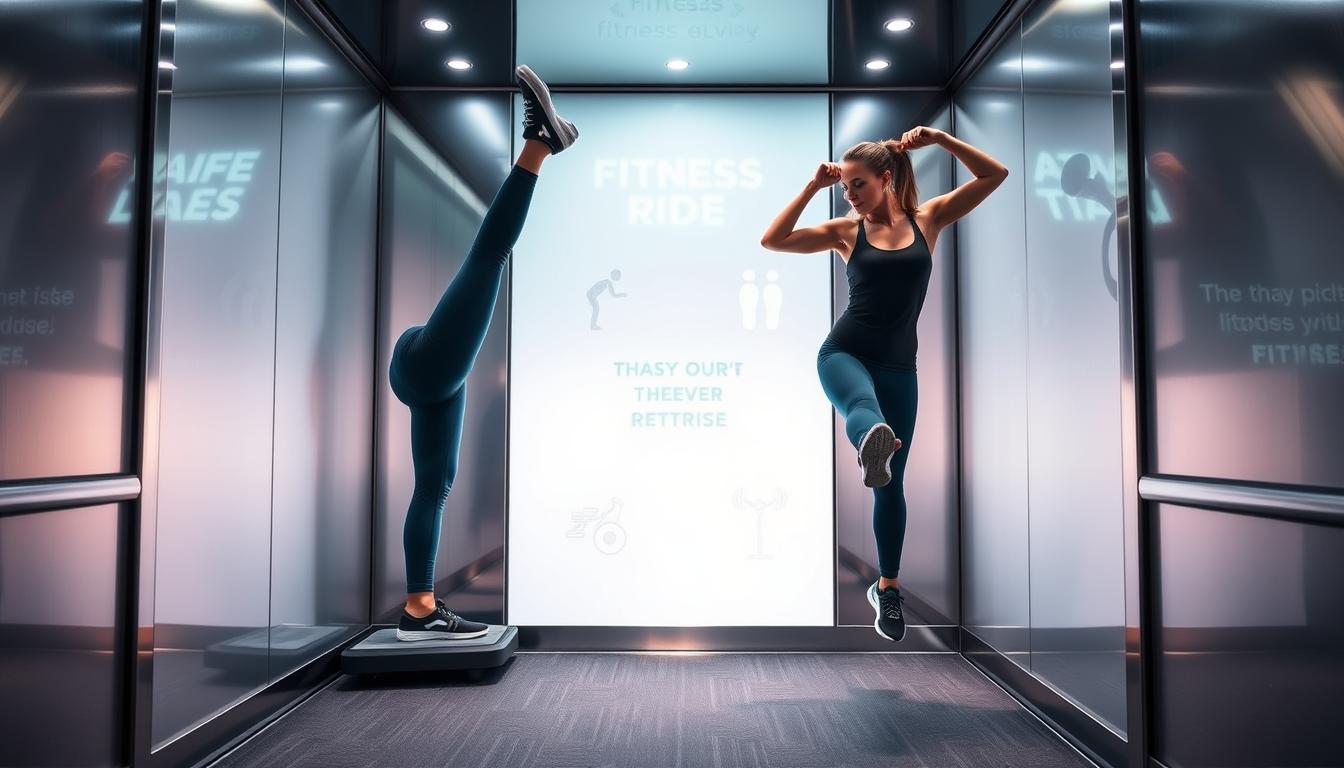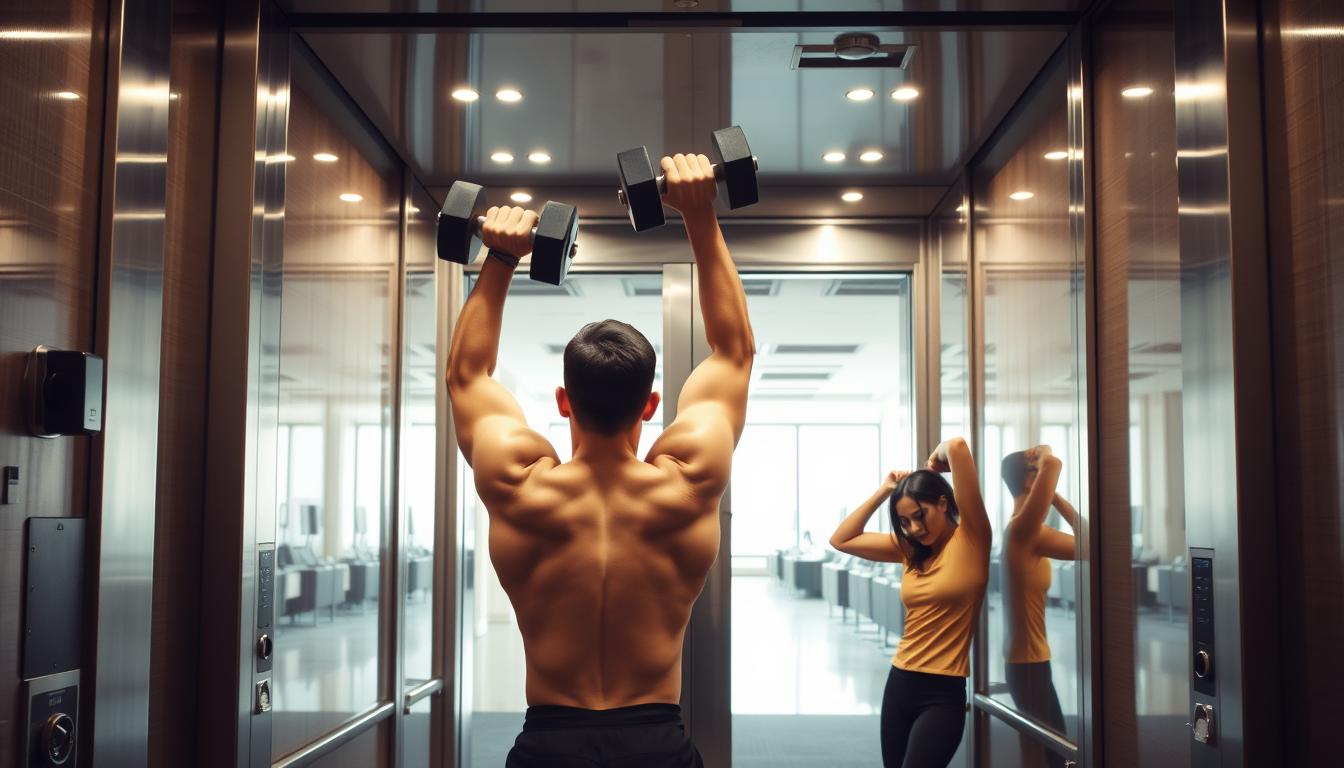Have you ever waited for an elevator and thought about fitting in a workout? The elevator workout lets you use bodyweight exercises during those waiting times. These exercises don’t need any equipment. You use your own body weight for resistance. It’s great for everyone, no matter their fitness level. Beginners can start strengthening and improving their form easily.
This cool method turns boring wait times into productive exercise moments. It works your muscles, boosts stability, and increases your fitness level. Next time you’re waiting for an elevator, remember, it’s a chance to boost your fitness with easy bodyweight exercises!
The Benefits of Bodyweight Exercises
Bodyweight exercises are great for all fitness levels and settings. They’re easy to do without special gear or gym memberships. You can do them anywhere, fitting fitness into a busy day easily.
Convenience and Accessibility
Bodyweight routines are easy for beginners, with no equipment needed. You can exercise at home, work, or outside. This makes it easy to keep fit every day. They’re also safer for newbies than lifting weights.
Mobility and Stability Gains
Bodyweight exercises improve how we move in daily life. They make us stronger and fitter and help change our body shape without extra equipment. Research shows they cut body fat, up endurance, and make our hearts healthier.
By doing these exercises, our muscles work harder. This makes our movements smoother and boosts our overall skills.
Understanding Bodyweight Training
Bodyweight training uses your own weight to build strength and endurance. It doesn’t need extra equipment. This way of training focuses on exercises that make many muscles work together, including core stabilizers. Unlike lifting weights in a gym, bodyweight training is about moving freely and is great for everybody, no matter their fitness level.
What Are Bodyweight Exercises?
Exercises such as push-ups, squats, and planks are examples of bodyweight exercises. They don’t require anything but your body. You can do them almost anywhere, which is perfect for a quick session. These kinds of workouts are proven to build muscle and strength effectively.
How They Differ from Traditional Weight Training
Traditional weight training uses items like dumbbells and limits how you move. It also needs a gym. On the other hand, bodyweight training is flexible and convenient. It works multiple muscles at once, increasing fitness and stamina. Combining bodyweight with traditional training can improve balance and strength results.
Effective Bodyweight Exercises for All Levels
Bodyweight exercises are great for everyone, no matter your workout experience. Newcomers can adjust these exercises to suit them. Those more used to exercise will find tougher bodyweight moves to challenge them and build muscle.
Modifying Exercises for Beginners
Starting a fitness journey? Bodyweight beginner exercises build a strong base. They can be made simpler to boost fun and involvement. Check out these easy-to-do exercises:
- Knee Push-Ups: These are easier than regular ones, putting less strain on you while helping you keep good form.
- Wall Squats: Doing squats against a wall builds leg muscles without too much stress.
- Dead Bug: Lying down, you stretch out opposite arms and legs to work your core, keeping your back flat.
- Bird Dog: On hands and knees, lift one arm and the opposite leg to work on your coordination and stability.
Challenge for Experienced Athletes
Want a more intense workout? Try these advanced bodyweight exercises. They make workouts harder, engage muscles more, and help them grow. Give these a go:
- Jump Lunges: They’re energy-packed, boost strength, and help your heart health.
- Superman: This one targets your lower back as you lift your limbs off the ground while lying down.
- Mountain Climbers: This fast, full-body move keeps your heart pumping.
- Plank Variations: Move from standard planks to more challenging ones for a tougher workout.
By adjusting exercises, anyone can find the right level of challenge. Adding bodyweight exercises to your routine can majorly boost strength and stamina, no matter your starting point.
Bodyweight Exercises in Elevator
Doing bodyweight exercises in elevators is a smart way to use your downtime during the day. It turns a usually still moment into a chance for a quick workout. You can do effective exercises in the small space of an elevator, boosting strength and coordination.
Utilizing Idle Time for Fitness
Bodyweight workouts in an elevator are great for your core strength and stability. They’re easy to fit into any schedule, for people at all fitness levels. In just a few minutes, you can change waiting time into a beneficial workout. Here are some exercises to try:
- Calf raises
- Wall sits
- Mini squats
Quick Routine: 5-Minute Elevator Workout
A 5-minute elevator workout includes 10 different bodyweight exercises. These exercises work on your major muscle groups. The workout increases reps from 10 to 100, focusing on legs, core, and heart health. Keeping the right form is key to getting the most out of it and staying safe. You’ll see improvements in how you move and your posture, making for a full fitness boost.
Key Muscle Groups Targeted
Bodyweight exercises are great for building strength in many muscle groups. They help focus on certain body parts for even growth, boosting fitness. Here are the main muscle areas worked by these exercises.
Upper Body Strength
The upper body includes big muscle groups like the chest, back, shoulders, and arms. Here are some top exercises:
- Push-ups for chest development
- Dips to target triceps and shoulders
- Pull-ups for back strength
- Bodyweight rows for stronger shoulders
Core Stability and Strength
Having a strong core is key for fitness and staying stable. Working on the core also helps with better posture and stops injuries. The best exercises for this area are:
- Planks for holding power and stability
- Hanging knee raises to work the abs
- Russian twists for side-to-side strength
- Mountain climbers for moving core exercises
Lower Body Development
For good balance and movement, a strong lower body is needed. The big muscles worked are the quads, hamstrings, glutes, and calves. Here’s what helps build the lower body:
- Squats for all-around leg strength
- Lunges for better stability and coordination
- Calf raises to make calf muscles stronger
- Glute bridges for focusing on the glutes
The Best Bodyweight Exercises for Building Muscle
Bodyweight exercises are a great way to build muscle using your own body’s resistance. They focus on strength and endurance. Here are top picks for bodyweight exercises that can be done anywhere and boost muscle growth.
Effective Movements to Include
Include these exercises in your workouts for the best results:
- Push-ups: They work on the chest, shoulders, and triceps. Try 3 sets of 12 to 15 reps.
- Close-Grip Push-ups: By placing hands closer, you work more on your triceps. Do 3 sets of 10 to 12 reps.
- Inverted Bodyweight Row: Use a bar or sturdy table for building back strength. Go for 3 sets of 8 to 10 reps.
- Lunges: They’re great for balance and strength. Perform 3 sets of 8 to 10 reps for each leg.
- Burpees: Perfect for full-body strength and cardio. Do 2 to 4 rounds of 40 seconds work, with 20 seconds rest.
- Jump Squats: Boost your power and stamina with 30 seconds of work and then rest for 30 seconds.
Combining Strength and Endurance
Mixing exercises that improve strength and endurance is vital. For instance, mountain climbers work on your core and increase cardio endurance while engaging muscles. By including a mix of strength and endurance exercises, you create a well-rounded workout. This includes push-ups and pull-ups for strength, with burpees and jump squats for endurance, leading to better fitness.
Creating Your Quick Bodyweight Workout Plan
Creating a workout plan with a busy schedule can seem tough. But the key is to choose exercises that give you the most value for your time. Bodyweight exercises are great for this. You can do them almost anywhere without any special gear. Here’s a plan that fits into a hectic week. It works different muscles in short sessions.
Sample Workout for Busy Schedules
- Days: 3-4 times a week
- Exercises:
- Squats
- Push-ups
- Pull-ups
- Deadlifts (can be modified with light weights or bodyweight variations)
- Sets: 2-5 sets for each exercise
- Reps: Start with 8-12 reps, increasing as you progress
Each workout should last about 45 minutes to an hour. You should aim to complete 10-20 sets in total. Remember, it’s also important to rest for 1-2 minutes between sets. This keeps the workout intense.
Timing and Frequency Recommendations
Make your workout plan even better by adding short active breaks into your day. These can fit into work breaks or any spare moments. Regularly doing these short exercises can bring big results even when you’re really busy. Begin with basic bodyweight moves. As you get stronger, add more reps or try harder versions of the exercises.
Incorporating HIIT with Bodyweight Movements
Mixing HIIT with bodyweight moves can really boost your fitness and health. This intense workout not only gets your heart healthier but also helps you lose fat faster. The best parts? You burn more calories, your heart gets better at recovering, and your muscles can go for longer.
Benefits of High-Intensity Training
High-intensity training works out both your aerobic and anaerobic systems. This means you’ll get stronger and have more stamina. With short bursts of tough exercise followed by little breaks, HIIT makes your workouts really efficient. Plus, adding bodyweight exercises means you don’t need a lot of gear to get fit.
Structure of a Bodyweight HIIT Session
Creating a bodyweight HIIT workout changes based on your experience. If you’re just starting, try 40 seconds of intense exercise with 20 seconds to rest for four rounds. If you’ve been at it awhile, do 60 seconds of hard work with 30 seconds of rest, also four times. And for the veterans? Push it to 90 seconds of effort with 30 seconds to rest, or do quick 20 seconds of exercise with only 10 seconds to rest, eight times.
- Start with warm-ups like jumping jacks to get going.
- Add in bodyweight exercises such as burpees and jump squats. Try doing three sets of burpees, making sure each one is explosive to pump up your heart rate.
- Keep the intensity high with mountain climbers. Do them by switching legs back and forth in a plank stance for 30 seconds.
- End with cool-downs like easy walking and the child’s pose to help your body recover.
Keep an eye on your progress by doing the same exercises every week. It’s important to rest well between your workouts to avoid getting hurt and to let your body get stronger from these intense HIIT sessions.

Overcoming Common Challenges
Many people find it hard to stick to their workout plans because of tight schedules and low motivation. Finding the right way to stay on track with your fitness dreams is possible, even with little equipment. Learning how to manage your time and boost your motivation can change problems into chances for growth.
Time Management Strategies
It might look tough to find time to exercise, but a good plan makes it easier. Here are some tips:
- Try taking short walks during the day. Just 10 minutes each can help, without the need for a long workout.
- Wake up earlier to spend 30 minutes exercising before your day begins.
- Walk more by parking your car further away or choosing to walk when you can.
- Use your lunch break to go for a quick walk. Wearing comfy shoes helps.
- Treat your workout time as an important meeting to keep it a top priority.
Staying Motivated with Minimal Equipment
Keeping up your motivation is key for a steady workout routine. Try these ideas:
- Start with small goals, like 20 minutes of exercise three times a week, to keep it doable.
- Join low-cost exercise groups in your area to meet new people.
- Begin by working out alone to gain confidence. Use simple exercises or items like resistance bands.
- Keep your workouts interesting by changing activities. Try walking, swimming, or cycling.
- Fit in exercise by walking around while you wait for things, like family members.
Tips for Progressing Your Bodyweight Routine
To get better at your bodyweight routine, you need smart strategies. Focus on tracking your growth, doing different exercises, and avoiding plateaus. These steps will help you get stronger and more skilled.
Tracking Your Growth
It’s important to keep a detailed log of your workouts. Write down how many repetitions and sets you do, and the kinds of exercises. This lets you see your improvements and tweak your plan as needed.
Focus on mastering holds like planks and move to tougher versions when ready. Remember to breathe properly during these exercises. Also, try exercises like the horse stance squat to improve strength and hip mobility.
Implementing Variety to Avoid Plateaus
Adding different exercises stops your workouts from getting boring and keeps you from hitting a plateau. Mix in things like kettlebells or barbells with your bodyweight training. Also, try quick movements like jump squats or push-ups with a clap.
Using slow and controlled movements with your usual exercises can make your muscles work harder. Keep challenging yourself by changing up your routine. This helps you continue to get better and makes your workouts more effective.
Safety and Injury Prevention
It’s important to be safe and avoid injury when doing bodyweight exercises. Making sure you’re doing each exercise correctly helps prevent injury. When you know the right way to move, you keep your body aligned. This lowers your chance of getting hurt and helps you do well in your fitness journey.
Importance of Proper Form
Learning how to do bodyweight exercises the right way is crucial. It means planning how you move carefully. Keeping your spine straight helps you avoid bad posture that can be dangerous.
For example:
- Goblet Squats can improve lower body mobility and stability.
- Bulgarian Split Squats target strength imbalances and enhance knee stability.
- Walking Lunges enhance functional strength, crucial for avoiding injuries.
- Lateral Lunges improve balance while targeting inner thigh muscles.
These exercises not only make you stronger but also help prevent injury when done correctly.
Listening to Your Body’s Signals
Paying attention to how your body feels is key to preventing injuries. Knowing when you’re uncomfortable, in pain, or tired lets you tweak how hard you work out. This helps stop overtraining. Heavy stuff should be lifted with help. For example, lifting something over 50 pounds should be a team effort.
Adjusting how you train based on what your body tells you improves your overall performance. It also lowers the risk of getting hurt from doing too much or using bad form.
Conclusion
Bodyweight exercises are a great way to stay fit that fits easily into your life. They help improve your heart health, make your muscles and joints stronger, and help you burn calories. By doing simple exercises like squats, planks, and push-ups every day, you can build a fitness habit that lasts.
But it’s not just about physical health. These exercises also make you feel happier and less stressed by releasing endorphins. They help you pay more attention to the moment and feel more connected to the world around you. So, you end up with a healthier body and a calmer mind.
Starting bodyweight exercises means anyone can get fit, no matter their skill level. Look for chances to move more during your day, like taking the stairs. Begin today, and take small steps towards a healthier, happier life.



